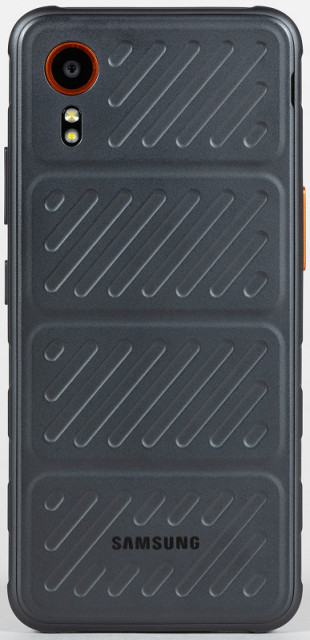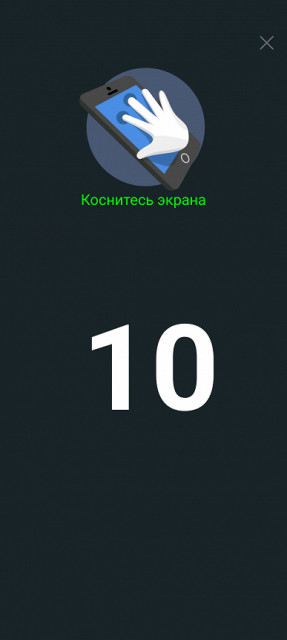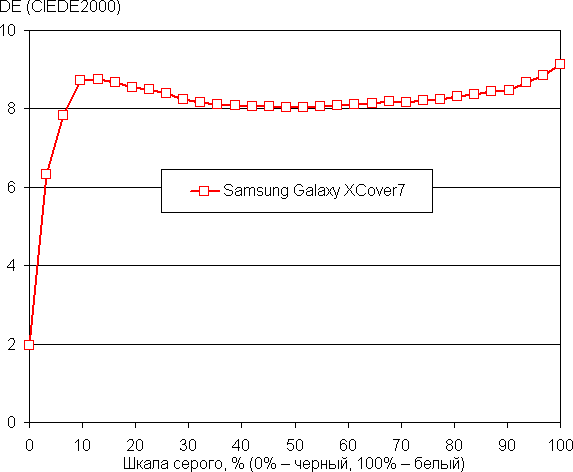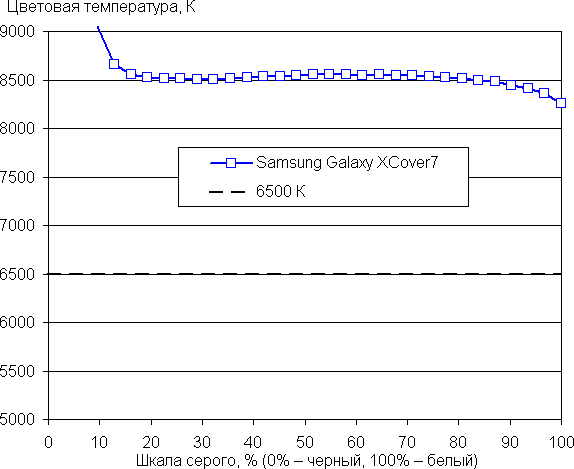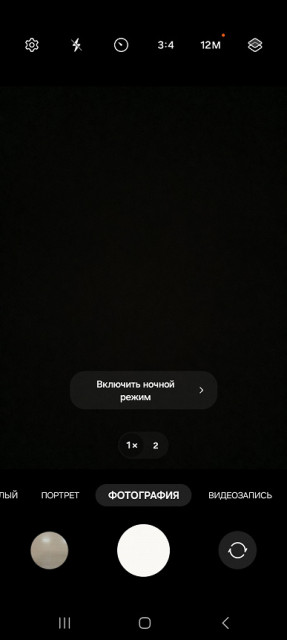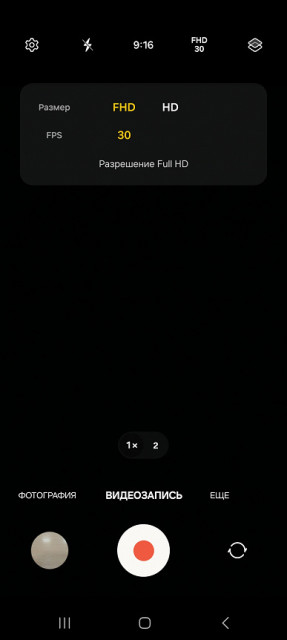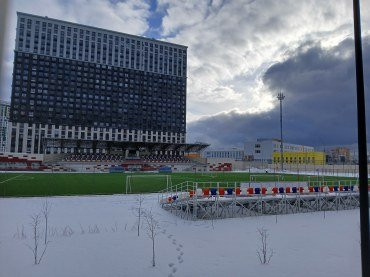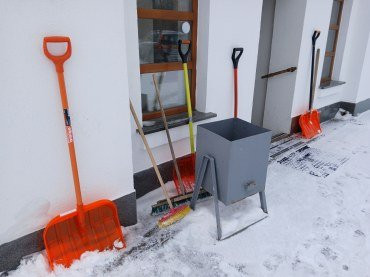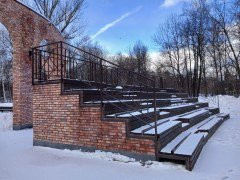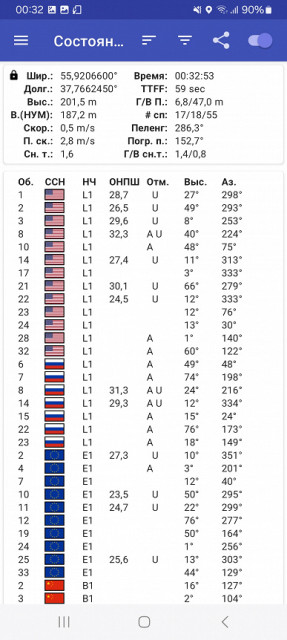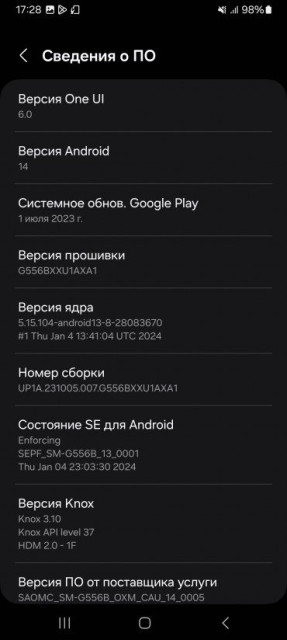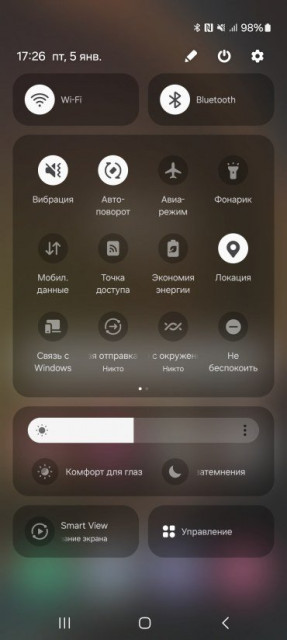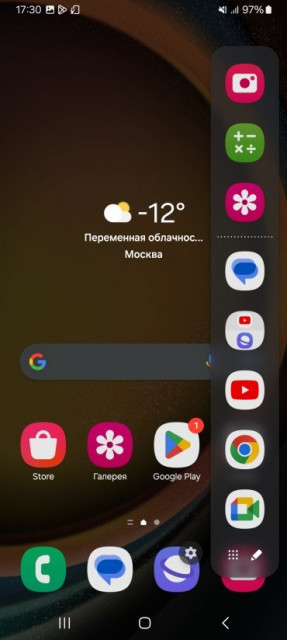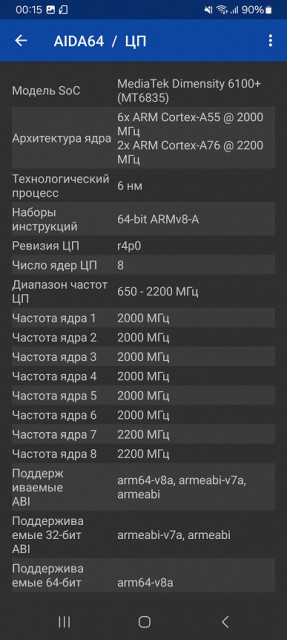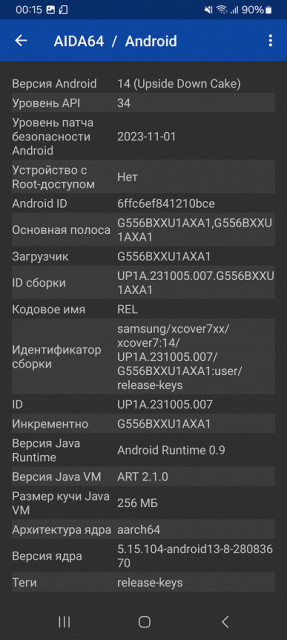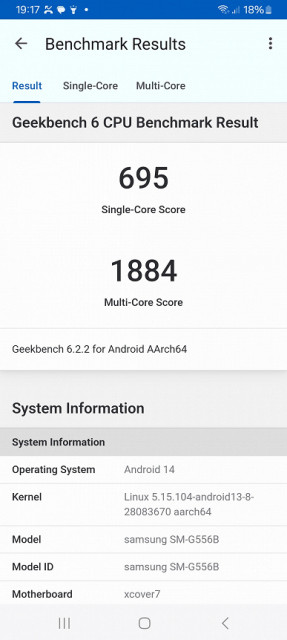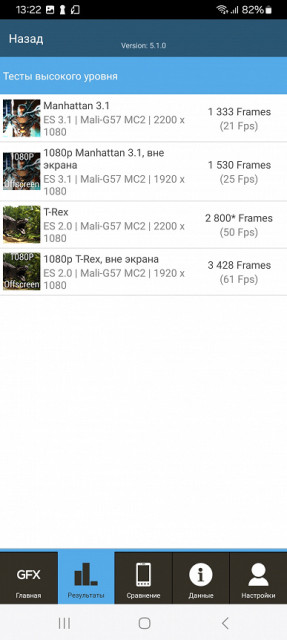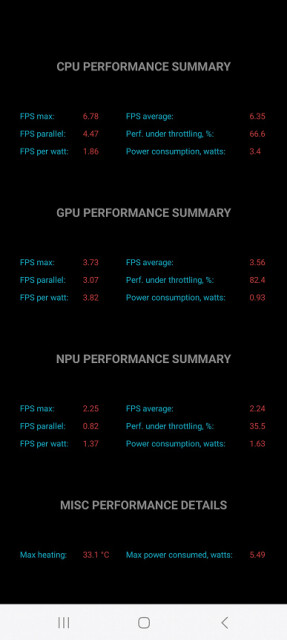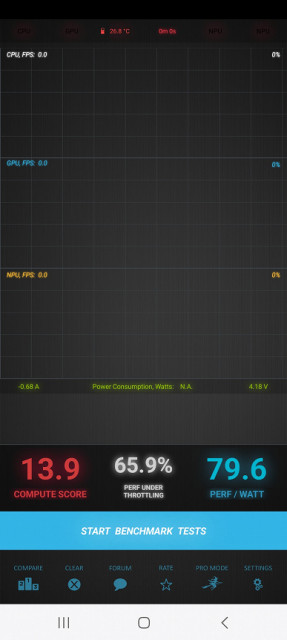Samsung's XCover line of rugged smartphones is now in its seventh generation, but most users still know little about the series. The Korean manufacturer targets the corporate segment, concluding contracts with enterprises, and officially these devices rarely appear on retail store shelves. Despite this, we have access to the Samsung Galaxy XCover7 and are ready to present its specifications. Perhaps this will be useful to someone, given several unique features of this rugged smartphone designed to work in extreme conditions.
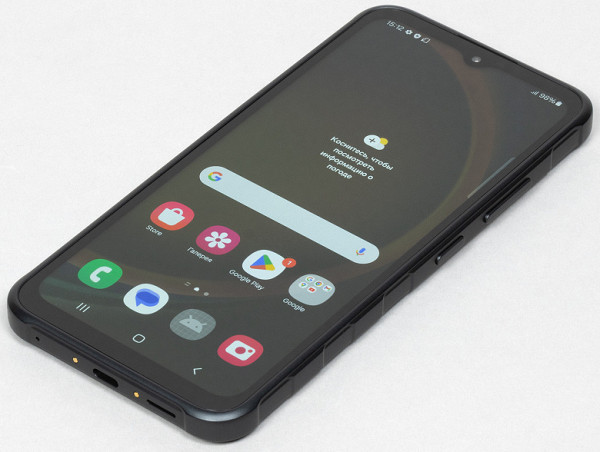
Key Features of Samsung Galaxy XCover7 (Model SM-G556B)
- SoC Mediatek Dimensity 6100 Plus MT6835, 8 processor cores (2×Cortex-A76 @2.2 GHz + 6×Cortex-A55 @2.0 GHz)
- GPU Mali-G57
- Operating system Android 14, One UI 6.0
- Touch display IPS, 6.6″, 1080×2408 (FHD+), 60 Hz, 20:9, 400 ppi
- RAM 6 GB, internal memory 128 GB
- microSD support (up to 1 TB)
- Support Nano-SIM (1 piece), e-SIM
- Networks 2G GSM, 3G WCDMA, 4G, 5G
- GPS, Glonass, Galileo, BDS, QZSS
- Wi-Fi 5 (2.4/5 GHz)
- Bluetooth 5.3, A2DP, LE
- NFC
- USB 2.0 Type-C, USB OTG
- 3.5mm headphone audio output
- Camera 50 MP, video 1080p@30 fps
- Front camera 5 MP
- Proximity and lighting sensors, magnetic field, accelerometer, gyroscope, barometer
- Fingerprint scanner (side-mounted)
- Protection IP68, MIL-STD-810H
- Battery 4050 mAh
- Pogo Dock Charging Contacts
- Dimensions 169×80×10.2 mm
- Weight 240 g
Appearance and ease of use
The Samsung Galaxy XCover7 Pro features a rugged smartphone design with thick bezels, wide side bezels and durable rubberized corners designed to withstand shocks and drops. The appearance of the device expresses reliability and durability, which corresponds to the style of a smartphone designed for use in extreme conditions. We note the absence of metal side trims, which are sometimes present on similar devices, which makes the Samsung Galaxy XCover7 Pro less “rough” in this regard.
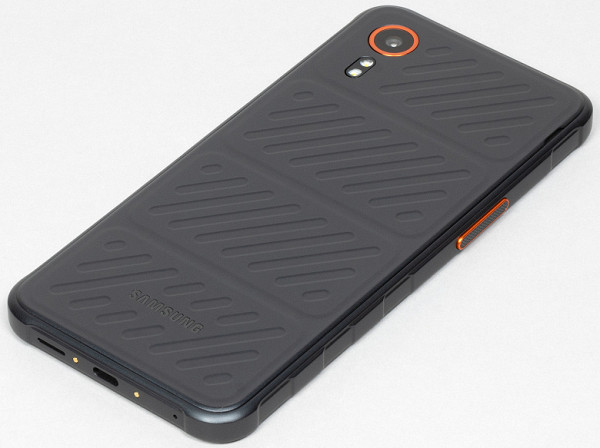
The back of the smartphone has a matte, non-slip and non-marking coating, and also has raised oblique stripes that can be felt when touched. These tactile elements stand out clearly against the overall surface, providing maximum grip on the device and preventing it from falling out, even when your fingers are wet. Durable plastic has successfully passed the tests, withstanding test drops of the smartphone from a height of human height.

The front glass of the screen has a small protruding protective edge around the entire perimeter. All these additional protective elements, of course, increase the size and weight of the device, but only slightly: the device weighs 240 g and its thickness is 1 cm, which are excellent indicators for a secure smartphone. It can be argued that for an “off-road” smartphone, the device looks very elegant.
However, there is a dubious point: in the early models of the Galaxy XCover series, the back cover was removable and attached with a screw, which eliminated the possibility of it bouncing off when hitting a hard surface. In the current version, a thin plastic panel is held on the body solely by friction, without additional fixing elements. Our human-height test drops didn't cause any concern and the cover stayed securely in place, but it's possible that it might pop off under heavier impacts.

The removable back cover is equipped with an internal rubber gasket to prevent moisture from penetrating the internal components. Even when the smartphone is completely immersed in water, all internal elements remain dry. According to the IP68 standard, the smartphone body is waterproof to a depth of 1.5 meters for 30 minutes and is protected from dust, dirt and sand. The device also meets the military standard MIL-STD-810H, providing protection against drops of up to 1.5 meters. After immersion in water, the smartphone remained fully functional.
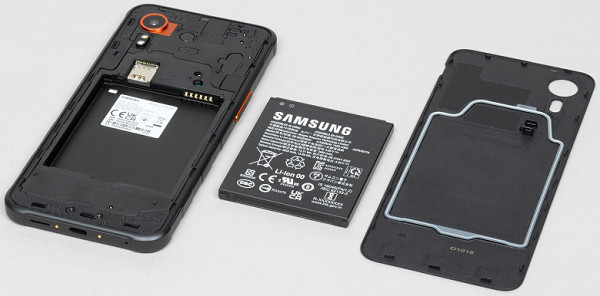
A slot under the protective cover allows you to install a Nano-SIM card, and next to it is a slot for a microSD memory card. If you need to add additional mobile numbers, virtual e-SIM cards are supported.
Thanks to the flat back and non-bulging camera, the smartphone lies stably on a hard surface, minimizing wobble when interacting with the screen. An additional protective cover is unnecessary in this case.

Regarding controls, in addition to the two usual buttons on the right side, there is an additional button on the left side. This button is highlighted with an orange rim and has a tactile texture. This is a programmable button that provides the ability to select the desired function, such as quickly activating the underwater camera, accessing the flashlight, taking a screenshot, or launching any other applications.
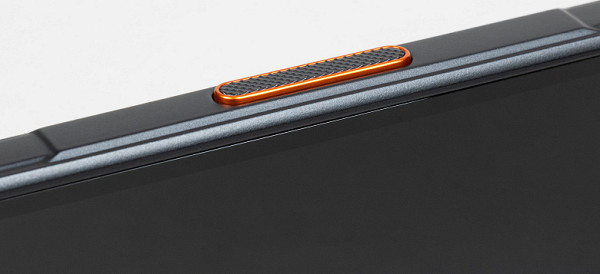
The mention of underwater shooting is not accidental: in water, the touch screen does not respond to finger touches, so you can activate the camera only using the soft key, and start and stop shooting using the power button.
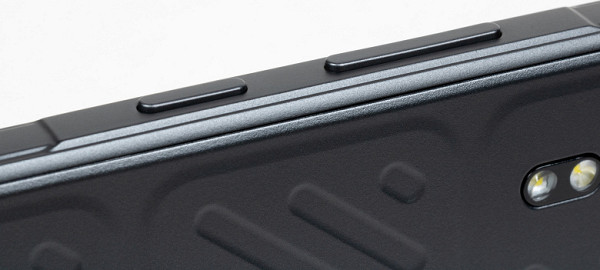
The front camera is single, it is installed in a drop-shaped cutout in the screen.
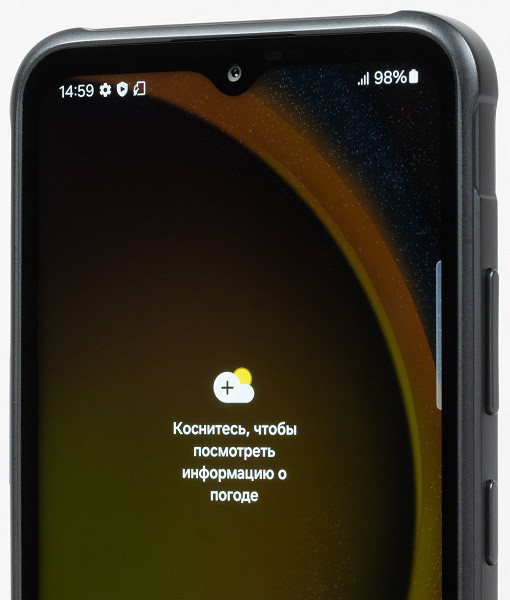
At the bottom end there is a conversational microphone, a speaker and a USB Type-C connector.

The top end contains a 3.5 mm audio output for a standard mini-jack of a wired headset, as well as an additional microphone hole.

Screen
The Samsung Galaxy XCover7 smartphone is equipped with a 6.6-inch diagonal IPS display with a resolution of 1080×2408, protected by flat Corning Gorilla Glass Victus Plus. The screen dimensions are 68x153 mm, and the pixel density is 400 ppi. Only 60Hz refresh rate is available. The screen supports touch sensitivity adjustment, making it easier to use the device with gloves.
The front surface of the screen is made in the form of a glass plate with a smooth reflective surface that is scratch-resistant. The anti-glare properties of the screen are rated higher compared to the Google Nexus 7 (2013) screen. The outer surface of the screen is equipped with an effective grease-repellent coating, which makes the process of cleaning fingerprints easier and slows down their appearance compared to regular glass.
When manually adjusting the brightness and displaying the white field in full screen, the maximum brightness value reaches 490 cd/m². In bright light and using automatic adjustment, this value increases to 580 cd/m². The maximum brightness is at a high level, allowing you to use the smartphone even in bright sunshine outside. The minimum brightness value for manual control is 2 cd/m², which allows you to comfortably use the device in complete darkness. Automatic brightness adjustment based on the light sensor ensures adequate adjustment of screen brightness to changes in external conditions.
The smartphone uses a 6.6-inch IPS display with a resolution of 1080×2408, protected by flat Corning Gorilla Glass Victus Plus glass. The screen has adjustable touch sensitivity, making it easier to use the device with gloves.
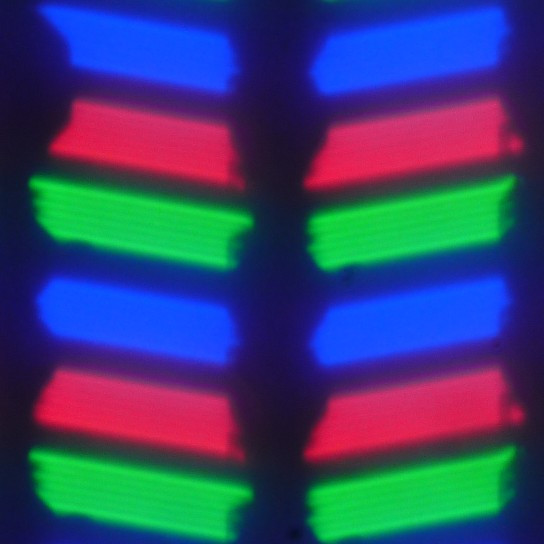
Here are images showing the same scenes on the screens of a smartphone and a Nexus 7. Initially, set the brightness of the screens to approximately 200 cd/m², and set the color balance on the camera to 6500 K.
The photographs show white fields located perpendicular to the screens:
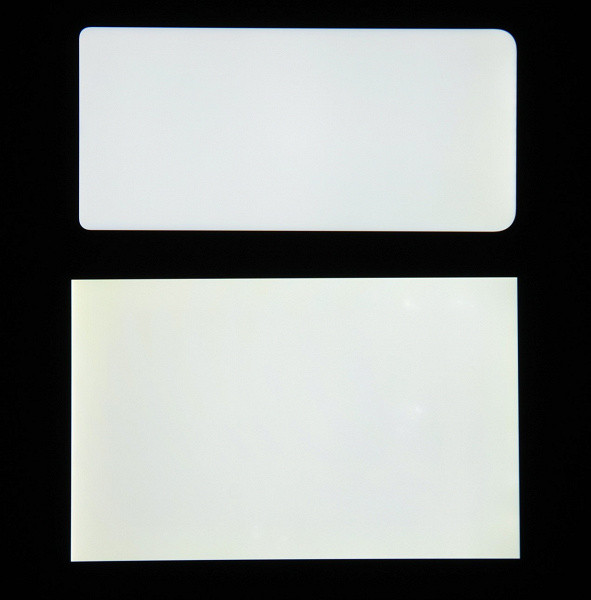
Note the good uniformity of brightness and color tone of the white field.
And a test picture:
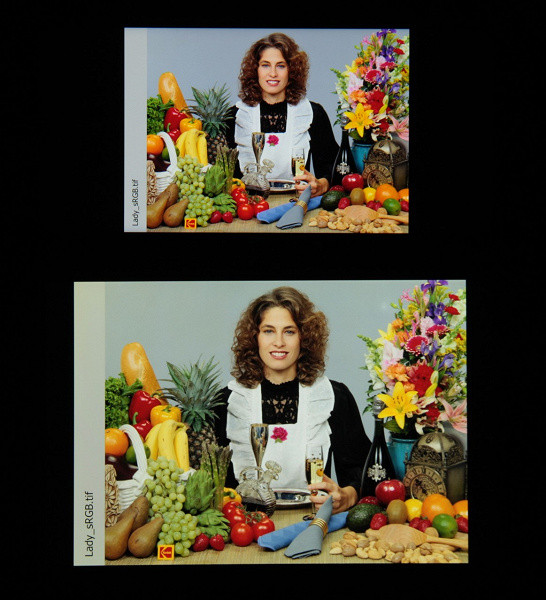
Colors on the smartphone screen appear oversaturated and the color balance is different from the Nexus 7 screen. It is important to note that photographs cannot fully convey the color quality and are used for illustrative purposes only. This is due to the fact that the spectral sensitivity of the camera sensor does not exactly match human vision.
The smartphone screen has good viewing angles, maintaining colors at large tilt angles and without distorting shades. However, when deviated diagonally, the black field becomes lighter, remaining a relatively neutral gray.
When viewed directly, the uniformity of the black field is high (the brightness of the smartphone’s backlight is set to maximum):
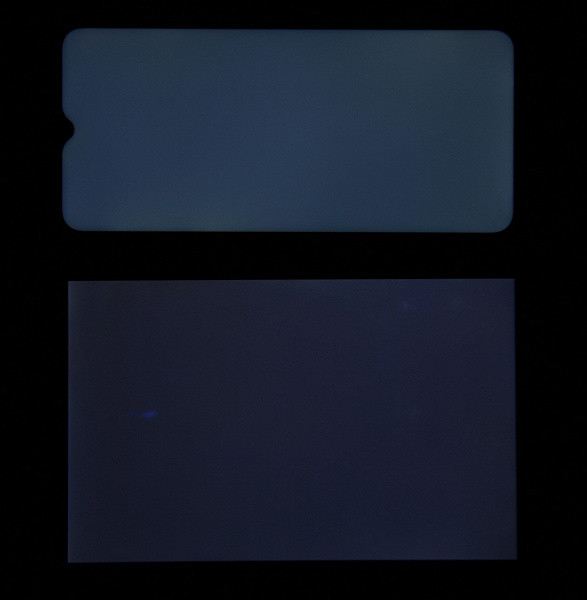
The contrast on the smartphone is high, approximately 1200:1 in the center of the screen. The response time from black to white and back is 18 ms (9 ms on + 9 ms off). The transition between 25% and 75% gray halftones takes a total of 30 ms.
The gamma curve, constructed using 32 points with equal intervals of shades of gray, showed no blockages in highlights or shadows. The value of the power function approximation is 2.24, slightly higher than the standard value of 2.2. The real gamma curve deviates little from the power law:

This device has dynamic adjustment of the backlight brightness, corresponding to the nature of the displayed image. However, the dimming of the backlight is only noticeable in very dark or medium-dark images and has little impact on overall image quality.
The color gamut of the device exceeds the sRGB standard and closely approaches the DCI space:
Let's look at the spectra:

The spectra of the components are well separated, providing a wide color gamut. However, for consumer devices, a wide color gamut is considered a disadvantage, as the colors of images oriented to the sRGB space (which is the vast majority of images) become unnaturally saturated. This is especially noticeable on recognizable shades such as skin color, as demonstrated in the photographs provided.
The average gray scale balance is due to the fact that the color temperature is well above the standard 6500 K. However, the deviation from the blackbody spectrum (ΔE) remains below 10, which is considered acceptable for consumer devices. It is important to note that color temperature and ΔE remain stable from hue to hue, which has a beneficial effect on the visual perception of color balance. (Areas with the darkest shades on the gray scale can be excluded from consideration, since color balance there is not so important, and the error in measuring color characteristics at low brightness can be significant.)
There is a setting that allows you to reduce the intensity of the blue component.

Regarding bright light, it can affect the circadian rhythm, but reducing the brightness to a comfortable level, rather than changing the color balance (in particular, reducing the contribution of blue), is a more sensible approach. These settings can be used to correct color balance, but lowering the color temperature may increase ΔE, which may not be desirable.
This device does not seem to support DisplayPort Alt Mode for USB Type-C, which means it cannot output image or sound to an external device when connected to a USB port.
Bottom line: The screen has high maximum brightness and excellent anti-glare properties, making it suitable for outdoor use in bright light. In complete darkness, the brightness can be reduced to a comfortable level. The mode with automatic brightness adjustment works adequately. The screen also has an effective oleophobic coating, no air gap and no invisible flicker. High contrast (1200:1) is another plus. However, there is some black instability as the viewing angle changes and colors are oversaturated. Considering the screen requirements for this class of devices, its quality can be considered high.
Camera
The Samsung Galaxy XCover7 smartphone is equipped with only one rear camera with a 50 MP matrix (1/2.76″ sensor) and an f/1.8 lens. The camera is equipped with phase detection autofocus, but it does not have optical image stabilization.
There is a quick and convenient ability to switch between pixel binning (12.5 MP) and full resolution (50 MP) shooting modes. True, there is little point in doing this.
Overall, given that this is not a flagship camera, the camera provides acceptable image quality at full resolution. However, there are disadvantages such as noise and low detail, so using a maximum resolution of 50 megapixels is not always justified. Processing photos with pixel binning (12.5 megapixels) can improve the situation, but does not eliminate these shortcomings. Dynamic range allows you to process both the lightest and darkest areas of an image. In the case of snowy scenes, white balance can sometimes lean towards the cool spectrum, which is a common problem. The pictures are clear enough, have good sharpness and have enough contrast to highlight the volume. Although there is noticeable blur at the edges of the frame, key elements in the center remain well represented. Considering the limitations of conventional cameras in rugged smartphones, this device provides reasonable photography capabilities, even being able to capture barcodes and document work moments.
More examples of shooting in auto mode:
When shooting at night, image quality decreases significantly, noise appears, details deteriorate, and other shortcomings arise.
The front camera with a resolution of 5 MP is capable of recording video in 1080p resolution at 30 frames per second. At this resolution, the quality of the images is acceptable: the image is quite clear and detailed, but it may be less saturated and bright. It is possible to increase saturation in the editor after shooting. However, it is worth noting that there is some looseness of detail and video jitter in selfie video mode, which may remain irreparable.

The main camera of the smartphone is capable of recording video with a maximum resolution of 1080p at 30 frames per second. At this resolution, the image quality is normal, but the lack of stabilization may affect the stability of the video recording. The ability to record in 4K could provide greater detail. Overall, video recording performance is rated as average. The quality of the audio track when recording video remains at a good level.
Telephone and communications
The Samsung Galaxy XCover7 smartphone provides support for 4G and 5G networks, providing a stable connection in the urban conditions of the Moscow region. The device demonstrates reliable operation in wireless networks and ensures quick restoration of communications after possible interruptions. There is also support for e-SIM virtual SIM cards.
The smartphone is equipped with a wireless adapter with Wi-Fi 5 (802.11a/b/g/n/ac, 2.4/5 GHz) and Bluetooth 5.3, and also supports NFC. The device is equipped with a single-channel satellite navigation module, including GPS, Glonass, Galileo, BDS and QZSS. The initial stage of satellite detection during a cold start may take some time, but the positioning accuracy remains at a high level.
The sound quality of the speaker during calls is very high, providing volume and clarity. The vibration motor is very noticeable. The smartphone is equipped with all the necessary built-in sensors, including a gyroscope and even a barometer.
Software and multimedia
The Samsung Galaxy XCover7 smartphone provides support for 4G and 5G networks, providing a stable connection in the urban conditions of the Moscow region. The device demonstrates reliable operation in wireless networks and ensures quick restoration of communications after possible interruptions. There is also support for e-SIM virtual SIM cards.
The smartphone is equipped with a wireless adapter with Wi-Fi 5 (802.11a/b/g/n/ac, 2.4/5 GHz) and Bluetooth 5.3, and also supports NFC. The device is equipped with a single-channel satellite navigation module, including GPS, Glonass, Galileo, BDS and QZSS. The initial stage of satellite detection during a cold start may take some time, but the positioning accuracy remains at a high level.
The sound quality of the speaker during calls is very high, providing volume and clarity. The vibration motor is very noticeable. The smartphone is equipped with all the necessary built-in sensors, including a gyroscope and even a barometer.
The smartphone does not have stereo speakers. There is only one loudspeaker, it produces a loud, clear, pleasant sound. The 3.5mm audio output for wired headphones is also retained. There is support for Dolby Atmos.
Performance
The Samsung Galaxy XCover7 smartphone is powered by an octa-core MediaTek Dimensity 6100 Plus processor with Mali-G57 MP2 GPU. The amount of RAM is 6 GB LPDDR4X type. There is 128 GB of built-in UFS 2.2 storage, with the ability to install a memory card. It also supports connecting external devices via the USB Type-C port in USB OTG mode.
Although the platform is new and manufactured according to 6nm standards, performance in the AnTuTu test is estimated at approximately 350 thousand points, which can be considered average. However, this performance is enough for fast operation of the system and applications, as well as for games at medium graphics settings.
Testing in comprehensive tests AnTuTu and GeekBench:
All results obtained during testing of the smartphone were systematized and presented in tables. Typically, the tables also include the results of several other devices from different segments that were also tested on the latest versions of the benchmarks. This is done to visually compare numbers and evaluate performance. Unfortunately, it is impossible to present results from different versions of benchmarks in one comparison, so some worthy and relevant models remain outside the scope of this review, given that they were tested on previous versions of test programs.
| Samsung Galaxy XCover7 (MediaTek Dimensity 6100 Plus) | Ixxi Khan J8 Pro (Mediatek Helio G95) | Tecno Pova 5 (Mediatek Helio G99) | Vivo V27 (Mediatek Dimensity 7200) | Poco X5 Pro 5G (Qualcomm Snapdragon 778G) | |
|---|---|---|---|---|---|
| AnTuTu (v9.x) (bigger is better) | 344317 | 340480 | 383174 | 602528 | 536193 |
| GeekBench 6 (bigger is better) | 695/1884 | 661/1788 | 715/1976 | 1198/2686 | 941/2640 |
Testing the graphics subsystem in 3DMark and GFXBenchmark gaming tests:
| Samsung Galaxy XCover7 (MediaTek Dimensity 6100 Plus) | Ixxi Khan J8 Pro (Mediatek Helio G95) | Tecno Pova 5 (Mediatek Helio G99) | Vivo V27 (Mediatek Dimensity 7200) | Poco X5 Pro 5G (Qualcomm Snapdragon 778G) | |
|---|---|---|---|---|---|
| 3DMark Wild Life Extreme Vulkan (bigger is better) | 339 | 423 | 348 | 1165 | 687 |
| 3DMark Wild Life Vulkan (bigger is better) | 1224 | 1509 | 1252 | 4186 | 2450 |
| GFXBenchmark Manhattan ES 3.1 (Onscreen, fps) | 21 | 29 | 23 | 59 | 49 |
| GFXBenchmark Manhattan ES 3.1 (1080p Offscreen, fps) | 25 | 32 | 26 | 68 | 56 |
| GFXBenchmark T-Rex (Onscreen, fps) | 50 | 53 | 57 | 110 | 109 |
| GFXBenchmark T-Rex (1080p Offscreen, fps) | 61 | 85 | 64 | 160 | 132 |
Testing in browser cross-platform tests:
| Samsung Galaxy XCover7 (MediaTek Dimensity 6100 Plus) | Ixxi Khan J8 Pro (Mediatek Helio G95) | Tecno Pova 5 (Mediatek Helio G99) | Vivo V27 (Mediatek Dimensity 7200) | Poco X5 Pro 5G (Qualcomm Snapdragon 778G) | |
|---|---|---|---|---|---|
| Google Octane 2 (bigger is better) | 22282 | 18786 | 22823 | 29329 | 27070 |
| JetStream (bigger is better) | 70 | 52 | 72 | 87 | 73 |
Heat
We test for performance degradation when heated using the Burnout Benchmark program, which allows you to load the CPU, GPU and NPU:
| Stress on | Heating performance as a percentage of maximum |
|---|---|
| CPU | 67% |
| GPU | 82% |
| NPU | 36% |
Performance degradation due to overheating under heavy load is average.
Battery life
The Samsung Galaxy XCover7 smartphone is equipped with a removable battery with a capacity of 4050 mAh, which, despite its small volume, allows you to quickly replace the battery with a spare one. However, an additional battery must be purchased separately. When testing the device's autonomy at normal power consumption levels, without using power-saving features, the device showed satisfactory results, but was at the lower end of the spectrum among modern smartphones.
Testing was carried out at the minimum comfortable brightness level (approximately 100 cd/m²). The following testing scenarios were used: continuous reading in the Moon+ Reader application using the standard light theme, continuous viewing of HD video (720p) over a home Wi-Fi network, and playing Injustice 2 with automatic graphics settings.
| Battery capacity | Reading mode | Video mode | 3D Game Mode | |
|---|---|---|---|---|
| Samsung Galaxy XCover7 | 4050 mAh | 18:30 | 15:30 | 6:00 am |
| Ixxi Khan J8 Pro | 6150 mAh | 25:00 | 19:00 | 8:00 am |
| Tecno Pova 5 | 6000 mAh | 23:00 | 16:00 | 7:30 am |
| Tecno Camon 20 Premier 5G | 5000 mAh | 25:00 | 19:00 | 7:00 am |
| Vivo V27 | 4600 mAh | 25:00 | 19:00 | 7:00 am |
| Poco X5 Pro 5G | 5000 mAh | 18:00 | 20:00 | 7:00 am |
| Realme 10 Pro+ 5G | 5000 mAh | 19:00 | 18:00 | 5:00 a.m. |
| Xiaomi 12T | 5000 mAh | 19:00 | 16:00 | 6:00 am |
All values mentioned represent maximum results achieved under ideal testing conditions, including no SIM cards installed. Any changes in operating conditions will likely lead to a deterioration in these indicators.
The Samsung Galaxy XCover7 smartphone supports a maximum charging power of 15 W and is fully charged in 1 hour 20 minutes. Wireless charging is not provided. The device also features a Pogo interface that makes charging easier by allowing multiple devices to be charged simultaneously using Pogo docking stations (not included).
It is possible to operate the smartphone without an installed battery when connected to an AC adapter. To do this, you must activate the appropriate mode, and also use a network adapter with a USB Type-C cable that supports 9V 2.3A or higher, as well as PD 2.0 or higher. Working in battery-free mode entails a decrease in processor performance, as well as a decrease in maximum volume, display brightness and other parameters.
Bottom line
There is no official information about the price at the moment. However, smartphones with protection against external influences are constantly popular among their target audience, and, most likely, this new product will not go unnoticed. People leading an active lifestyle, involved in tourism or working in environments where equipment is exposed to heavy impacts (for example, on construction sites) can appreciate the benefits of such a secure smartphone. Additionally worth mentioning is the ability to shoot underwater using a dedicated hardware button and the ability to use the screen even with gloves.
Samsung Galaxy XCover7 has good performance and a bright, clear screen that will not lose its visibility on the street. The smartphone camera takes decent photos, corresponding to its level. The device supports major network standards and protocols. With its help, you can safely go fishing or to the mountains, and it will work in any adverse conditions. Although its autonomy is not the highest, and charging is not the fastest, this drawback is compensated by the ability to quickly replace removable batteries, which makes this model very convenient for use on long hikes.

